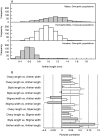Correlated polymorphism in cytotype and sexual system within a monophyletic species, Lycium californicum
- PMID: 26546375
- PMCID: PMC4724043
- DOI: 10.1093/aob/mcv167
Correlated polymorphism in cytotype and sexual system within a monophyletic species, Lycium californicum
Abstract
Background and aims: Polyploidy has important effects on reproductive systems in plants and has been implicated in the evolution of dimorphic sexual systems. In particular, higher ploidy is associated with gender dimorphism across Lycium species (Solanaceae) and across populations within the species Lycium californicum. Previous research on the association of cytotype and sexual system within L. californicum sampled a limited portion of the species range, and did not investigate evolutionary transitions between sexual systems. Lycium californicum occurs in arid regions on offshore islands and mainland regions in the south-western United States and Mexico, motivating a more comprehensive analysis of intraspecific variation in sexual system and cytotype across the full range of this species.
Methods: Sexual system (dimorphic vs. cosexual) was determined for 34 populations across the geographical range of L. californicum using field observations of pollen production, and was confirmed using morphological measurements and among-plant correlations of primary sexual traits. Ploidy was inferred using flow cytometry in 28 populations. DNA sequence data from four plastid and two nuclear regions were used to reconstruct relationships among populations and to map transitions in sexual system and ploidy.
Key results: Lycium californicum is monophyletic, ancestrally diploid and cosexual, and the association of gender dimorphism and polyploidy appears to have two evolutionary origins in this species. Compared with cosexual populations, dimorphic populations had bimodal anther size distributions, negative correlations between male and female floral traits, and larger coefficients of variation for primary sexual traits. Flow cytometry confirmed tetraploidy in dimorphic populations, whereas cosexual populations were diploid.
Conclusions: Tetraploidy and gender dimorphism are perfectly correlated in L. californicum, and the distribution of tetraploid-dimorphic populations is restricted to populations in Arizona and the Baja California peninsula. The analysis suggests that tetraploidy and dimorphism likely established in Baja California and may have evolved multiple times.
Keywords: DNA content; Lycium californicum; Solanaceae; dioecy; gender dimorphism; male sterility; plant mating system; polymorphism; polyploidy; sexual system.
© The Author 2015. Published by Oxford University Press on behalf of the Annals of Botany Company. All rights reserved. For Permissions, please email: journals.permissions@oup.com.
Figures




References
-
- Alonso C, Herrera CM. 2011. Back-and-forth hermaphroditism: phylogenetic context of reproductive system evolution in subdioecious Daphne laureola. Evolution 65: 1680–1692. - PubMed
-
- Ashman TL, Kwok A, Husband BC. 2013. Revisiting the dioecy–polyploidy association: alternate pathways and research opportunities. Cytogenetic and Genome Research 140: 241–255. - PubMed
-
- Bainard JD, Husband BC, Baldwin SJ, et al. 2011. The effects of rapid desiccation on estimates of plant genome size. Chromosome Research 19: 825–842. - PubMed
-
- Baker HG. 1959. Reproductive methods as factors in speciation in flowering plants. Cold Spring Harbor Symposium in Quantitative Biology 24: 177–191. - PubMed
Publication types
MeSH terms
LinkOut - more resources
Full Text Sources
Other Literature Sources

